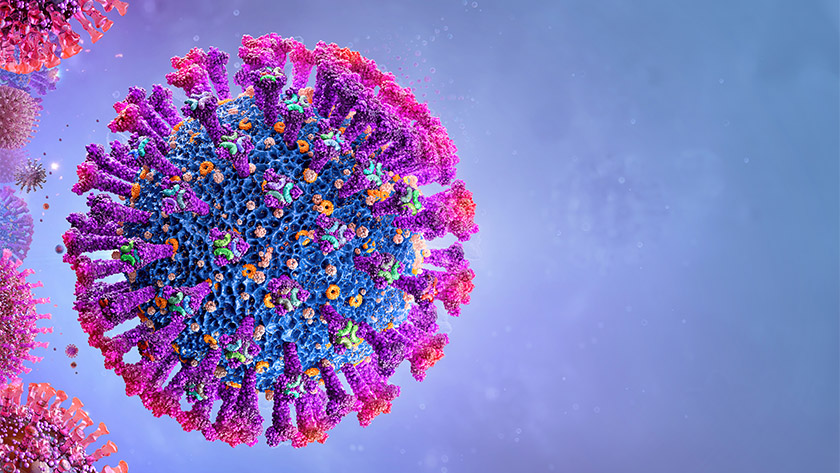Scientists have a detailed understanding of the way SARS-CoV-2, the virus that causes COVID-19, infects cells. A key factor is the presence of spike proteins on the surface of the virus particle (virion) that bind to the ACE-2 receptors found along the whole human respiratory tract. Unlike other respiratory viruses (eg influenza), SARS-CoV-2 spikes are highly flexible, allowing them to find and bind to more receptors. Also they are coated in sugar molecules (glycans) that help to disguise them from the immune system.1
The Alpha and Delta variants of the COVID-19 virus show mutations in the receptor-binding section of the spikes. The Delta variant has multiple spike mutations which both make it better at binding to the ACE-2 receptor and better at “hiding” from the immune system.1
Replicates much more rapidly
Strong binding, more immune evasion and more efficient entry into host cells means the Delta variant can replicate much more rapidly, making it more transmissible. Studies indicate the viral load in the airways of people infected with the Delta variant is up to 1000 times higher than the original or Alpha variant SARS-CoV-2. Even people who are fully vaccinated are shedding high numbers of virions with only mild or zero symptoms.2
A person’s viral load is determined by the cycle threshold (CT) value. This refers to the number of times a sample from an infected person needs to be processed through the polymerase chain reaction (PCR) (a laboratory amplifying tool) before the virus is detected. The higher the CT value, the less virus is present.3
According to the US Centres for Disease Control (CDC), the R0 number for the Delta variant is between 5 and 9.5. This means one person with the infection is likely to pass it on to between five and 10 other people. This makes the Delta variant more contagious than seasonal influenza, the common cold, the 1918 pandemic influenza and Ebola. The most comparable infectious transmission is with chickenpox. By contrast, the original SARS-CoV-2 has an R0 of between 1 and 2.2
Delta appears to cause more severe disease in the unvaccinated. Vaccines prevent severe disease but not the spread. Further, the time between exposure and becoming infectious is reduced for Delta from an average of six days to four days.4 This makes contact tracing a more difficult and urgent priority where there is Delta in the community.
The World Health Organization and scientists are closely watching a number of other variants (eg Eta, Kappa and Lambda). These have mutations predicted to increase transmissibility, disease severity or immune escape but have not yet reached global public health significance.5
Stopping transmission is essential to controlling the development of even more dangerous variants.
The more infections, the more chance there is that mutations will occur and natural selection will ensure the best mutations – those that improve viral infectivity – become dominant. The greater the R0 value of a disease, the higher the percentage of the population that needs to be vaccinated for herd immunity.
These are the reasons that effective public health messaging about prevention of transmission and vaccination, and the role of nurses in reinforcing these, are so important.
References
- Scudellari, M. (2021). How the coronavirus infects cells – and why Delta is so dangerous. Nature News. Accessed August 2021.
- McMorrow, M. (2021). Improving communications around vaccine breakthrough and vaccine effectiveness (PDF, 844 KB). Accessed August 2021.
- American Association for Clinical Chemistry. (2021). AACC recommendation for reporting SARS-CoV-2 cycle threshold (CT) values. Accessed August 2021.
- Li, B., Deng, A., Li, K., Hu, Y., Li, Z., Xiong, Q., Liu, Z., Guo, Q., Zou, L., Zhang, H., Zhang, M., Ouyang, F., Su, J., Su, W., Xu, J., Lin, H., Sun, J., Peng, J., Jiang, H., Zhou, P., Zhen, H., Xiao, J., Liu, T., Che, R., Zeng, H., Zheng, Z., Huang, Y., Yu, J., Yi, L., Wu, J., Chen, J., Zhong, H., Deng, X., Kang, M., Pybus, O. G., Hall, M., Lythgoe, K. A., Li, Y., Yuan, J., He, J., & Lu, J. (2021). Viral infection and transmission in a large well-traced outbreak caused by the Delta SARS-CoV-2 variant. Virological.org.
- World Health Organization. (2021). Tracking SARS-CoV-2 variants. Accessed August 2021.



